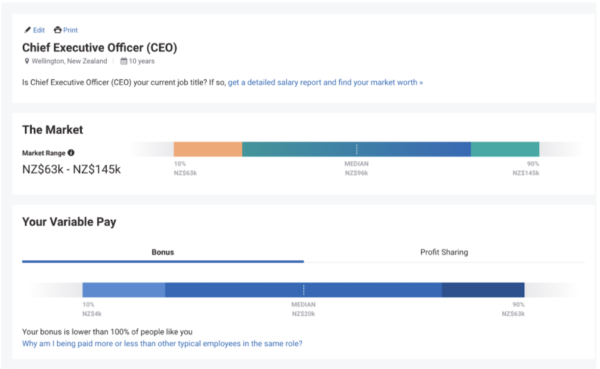Employers: Six quick and easy ways to set the salary on your next vacancy
Setting a salary for a brand new role can be tricky! And, if you are in the for-purpose space, you probably want to balance being fair, paying enough to get the best talent into your for-purpose organisation, all while not blowing the budget too! Setting a salary is not something many of us (except maybe any HR pros reading this) have a lot of experience with.
I've been involved in several exercises to set the salary for job vacancies, and recently a few people from not-for-profits have come to me to help with this. I know that many in the for-purpose world won't have the luxury to outsource this to the professionals, and need a DIY approach. The good news is that there are plenty of FREE and publicly available benchmarking tools to help, you just need to know where to start.
Below are my top tips to guide you in setting the salary for your next vacancy - and hopefully to help in making this process simple, straightforward and fair.
#1. Know the details
Have you nailed your job description and title? If not, stop now. You’ll need this for your salary research. There may not be an exact match for your role (particularly for some of the very unique roles in not-for-profits) so you’ll want to think of a few similar job titles that closely match what you are looking for.
If you already have a rough budget already assigned for this role, use this process to identify if you are offering a fair amount, and if not, identify which tasks and roles you might be able to drop from this position.
A common bugbear I hear from Do Good Jobs’ job seekers is that many of the part-time roles often look like they have the same responsibilities as a full-time job, but the salary and hours have been halved to fit the budget. Be realistic about how much can be achieved in the hours and carve out the priority tasks and responsibilities that will have the most impact.
Now might also be the time to identify some of the benefits they might receive on top of their salary and what this might equate too. For example, does it include use of a work vehicle, bonuses, flexible work hours, remote work opportunities, a phone subsidy etc?
Once you have these details you can press go on benchmarking the role.
#2. Let your fingers do the walking
Before you start researching, figure out where you will document your research. It is useful to have this information on hand if a candidate or your board questions how you settled on your salary (and a great reference point for future salary negotiations with employees). Get access to my FREE spreadsheet template here.
There are many free salary data sources available. My go-to faves include:
You can access one free report per year as a business, but can also research as a jobseeker. Payscale allows you to apply various filters including location filters, level of years’ experience and more. Many of these choices are optional.
Below is a search I completed for a Not-for-profit CEO role, with a filter for 10+ years of experience at a not-for-profit organisation based in Wellington, New Zealand.
You’ll note there is a big gap between the top and bottom for this role. I recommend looking at the market median. This is a useful starting point to check competitiveness as the median is less susceptible to extreme high and low salaries.
Payscale salary guide CEO not for profit NZ
RESOURCE: Here is the average salary of people in the not-for-profit sector in NZ.
Hays provides a simple salary checker (it is less detailed than Payscale) that helps you to understand what typical salaries are. Enter the job details and where it is based, and the salary checker will show how you compare to the highest, typical and lowest salaries for this position.
Seek also have a very swish salary insights tool providing a very nice looking infographic on various roles - including for the Community & Development sector. You can also get insights based on your region too.
#3. Apply your values
You will want to think about what compensation strategy is acceptable to your organisation. Maybe you have compensation guidelines developed, but for most for-purpose organisations it is not likely you'll have anything formalised. Some key things you might like to think about include:
Where do you want to be on the salary scale compared to corporate rates (or the rest of the sector)? Do you want to lead, meet or lag?
Are you committed to paying at, or above, the living wage? Find out more details here on the current living wage rate in NZ
Where does thisrate fit alongside your other positions in the organisation and what should the difference or multiplier be between your highest-paid role and the lowest-paid role?
What is the organisation’s capacity to pay (i.e. what can we afford to pay) and need to pay (i.e. what it will cost to get the right person into the role). I'd also like to suggest that if you can pay the same salary that corresponds with a corporate position, please do that! We need to move away from the "not-for-profit workers must be paid less" mentality. If you want the BEST people (and want to retain the best people) you need to pay fairly and equally.
Often the final salary approval may be a Board, budget or management decision, so having some solid research that benchmarks your salary can help in making this decision.
#4. Don’t forget to ask others in your sector for their insights.
Simply asking other local for-purpose leaders and corporate managers what they would pay can be insightful, and they may point you in the right direction for data on salaries in your sector too.
#5. Set a range
Now you might be ready to set a clearer salary bracket for this role. You might be tempted to say “salary negotiable” or “depends on experience”, but I advocate for salary transparency whenever you post any vacancy.
The reality is that you have a budget you are working within and, if you have done your research, you already know the range you are willing to offer, so state it! If you are using this strategy in the hopes that you can hire someone at rock bottom price, please reconsider whether this is a fair and good use of your, and the applicants, time.
The sensible, fair and ethical thing to do is to include the salary range in every job ad. If someone doesn’t want the job at the salary you are willing to pay, they won’t spend their time (and yours) applying for the position. Simple. There is nothing worse than having the perfect candidate, only to find that your salary expectations are wildly different.
Fact: many candidates will also NOT apply for a job where the salary is not listed, particularly in the not-for-profit sector because they fear that it is likely to be well under their ideal salary level - so you might miss out on amazing talent too! I asked a question on this topic to my Facebook community the other day - so don't just take my word for it, check out their responses here.
Having as narrow a band as possible (ideally within $10,000 to $20,000) allows you to factor in the experience of the individual you do recruit and place them on this scale.
#6. Don't set and forget
Peoples needs change, roles change and the world changes. It is useful to determine a process for review. While seeking professional advice every year to review your salary may be costly, you may want to consider getting a formal benchmark done every 3 to 5 years by an external person or agency and apply a simple increase based on the market or CPI in between (or do your own research again using the method I have listed above).
I hope these DIY tips on setting a salary help you in making the process of setting a salary a bit easier, fairer and more affordable.
Do you have any other idea or resources to share? Leave a comment below!




